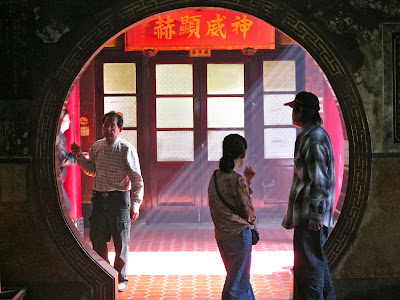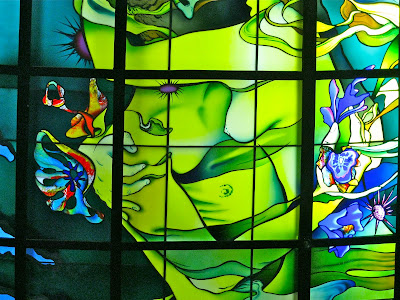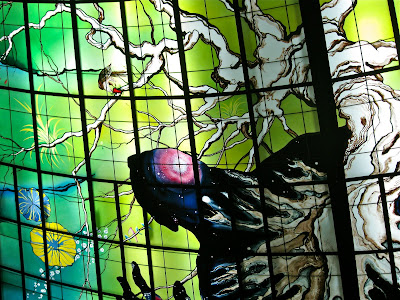
We spent the first few days in the city of Dashe (大社 or “Great Society”) with our friend Sasha Wang and her family, including her parents and sister, Iris. On Chinese New Year’s day, Sasha’s grandmother also came over.
Dashe is a small town that looks like every other Taiwanese town. It has its famous local produce (green jujubes, which were quite fortunately in season), its main old temple, its one “scenic” spot worth a visit, and several streets worth of pearl tea stands, convenience stores, breakfast hamburger restaurants, lottery stores, blue trucks and the requisite Café 85.
When we first arrived we were treated to a bowl of delicious, crisp jujubes just picked by a family friend. “I feel sorry for you northerners,” Mr. Wang said as he handed us the shiny fruit. “You have to eat all the so-so jujubes that we don’t want. We get the best ones! Once, I sent a case of these jujubes to my cousin in Taipei and he said ‘they’re great, but they arrived mostly rotten”. You can’t pick them right off the tree and still get them to Taipei, so you have to eat ones picked too early and they’re not as good.”

I felt lucky to have the chance to spend a few days in Dashe; it’s the sort of town you wouldn’t think to visit, and would have no reason to visit, unless you have a friend there. We suspect there's at least one foreigner in town because the city seems big enough to support a cram school or two, and there was one (one!) Taipei Times at the 7-11 when we went for coffee. "There is probably one expat in the entire town," Brendan said as he bought the paper, "and I took his Taipei Times!"
The upside of this is that we got to spend a few days in a sleepy Taiwanese town devoid of tourist hype or "Must See" destinations. Everything gets easier when there's nothing in particular that you have to see. It was fascinating to see a town from which the produce we eat in Taipei comes (rather like pineapples from Guanmiao, strawberries from Dahu, Lishan apples, Mingchih peaches or custard apples from Taidong) - a town that is, honestly, "flyover country".
For real - the High Speed Rail tracks go right through the edge of town. You cross under them to head up to the Guanyinshan Scenic Area. I spend a lot of time on the HSR and never really think about what the towns the tracks pass through are like so this was a fascinating glimpse from a different perspective.


The Wangs are masters of old school hospitality - the kind that people raved about in countries like India and Thailand before the tourist hordes showed up. We had our own room, delicious meals ("we can eat out if it's a bother" - "it's NO bother...they WANT to feed you") and while Sasha's parents don't drink coffee, Sasha knows that we're hopeless addicts and made sure that 7-11 coffee was the first thing we got every day. We both had a lot of fun in a town without much to see
The Wangs don’t celebrate Chinese New Year the way you’d expect. They follow Yi Guan Dao, which as far as I can tell is a type of Buddhism that still mandates praying to ancestors, eating vegetarian even for laypeople, and lots and lots of prayer on special days (more than you'd normally expect).
On New Year's Eve, we woke up and enjoyed rice porridge with various vegetarian additions including a dried product that I would have mistaken for beef jerky had I not known that it couldn't possibly have been. We then piled into the car and drove to Zuoying, where we helped burn ghost money ("you two are sooooo cute!" "Are we doing it wrong?" "No...it's just so funny to watch foreigners do that") and met Sasha's extended family, including her "Have Fun Uncle" (he likes to have fun - mahjong, wine, cards and other things that Sasha's parents don't indulge in), her grandmother, her older sister and her nephew.

"They always remember my English name," Sasha said, "because it sounds like 'What the ****!?' in Taiwanese." "What's that?" I asked, and Sasha told me (it's "sa shao" if you're curious) in front of her parents, who chortled heartily. Later, her father told us "not to tell anyone in Taipei that I'm a '大社人'", which he said in Taiwanese, which sounds just like the Mandarin 大色狼. Go ask someone if you can't read that.

The Wangs don’t celebrate Chinese New Year the way you’d expect. They follow Yi Guan Dao, which as far as I can tell is a type of Buddhism that still mandates praying to ancestors, eating vegetarian even for laypeople, and lots and lots of prayer on special days (more than you'd normally expect).
On New Year's Eve, we woke up and enjoyed rice porridge with various vegetarian additions including a dried product that I would have mistaken for beef jerky had I not known that it couldn't possibly have been. We then piled into the car and drove to Zuoying, where we helped burn ghost money ("you two are sooooo cute!" "Are we doing it wrong?" "No...it's just so funny to watch foreigners do that") and met Sasha's extended family, including her "Have Fun Uncle" (he likes to have fun - mahjong, wine, cards and other things that Sasha's parents don't indulge in), her grandmother, her older sister and her nephew.

Not that Sasha's parents are uptight; they're not against others eating meat, drinking alcohol or gambling, and as good old-school Taiwanese from the country, they're quite good at the occasional swear word or colorful comment.
"They always remember my English name," Sasha said, "because it sounds like 'What the ****!?' in Taiwanese." "What's that?" I asked, and Sasha told me (it's "sa shao" if you're curious) in front of her parents, who chortled heartily. Later, her father told us "not to tell anyone in Taipei that I'm a '大社人'", which he said in Taiwanese, which sounds just like the Mandarin 大色狼. Go ask someone if you can't read that.

...and their neighbor agreed. Foreigners burning ghost money is hilarious.
While the family cleaned the house we went into Kaohsiung - we offered to help and were roundly rebuffed - and visited Pier 2 in Yancheng. I'll write about that later.
For dinner, we ate a steaming, delicious vegetarian hot pot with faux duck, faux fish balls, faux squid and all manner of vegetables and beans. The imitation meat was excellent (some of it actually tasted like the real thing) and made mostly from mushroom, tofu and bean ingredients processed to bear a resemblance to meat.
We then watched a bit of the CNY television programming on Formosa TV - the Wangs, being from Kaohsiung, are rather deep green (lots of pro-Chen Chu and anti-Ma invective) before they went upstairs to pray. The ritual called for three prayers - one at 8pm, one at 9 and one at 10. We could have watched but Sasha insisted it was really not all that interesting, and so instead we stayed downstairs to watch the flamenco dancer on the left talk to the Snow Countess that Flash Gordon defeated on the right, mediated by the famous guy in the bowl haircut whom you'll recognize if you've spent even a week in Taiwan.

At that point, an uncle and aunt dropped off Grandma, who "was too tired to climb the stairs to pray". The Wangs own a four-story townhouse-like house, so this seemed reasonable. She retired to her room on the ground floor for a bit, but then came into the living room to talk to us.

Except that Grandma only speaks Taiwanese (and some Japanese). I only speak Chinese and English. She can't read Chinese (except characters on mahjong tiles). We did have a conversation, but I'm not sure how.
I learned a great many interesting things from Grandma. First, it's not that she can't climb the stairs to the top floor, though that is hard for her - she just doesn't really like to pray that much. "Sometimes it's OK...but they do it too much. I can't be bothered" was the gist of what she said.
I told Sasha this...her reply? "Finally, Grandma tells the truth! We always knew it because we don't really like it either! She can admit it to you!"
I told Sasha this...her reply? "Finally, Grandma tells the truth! We always knew it because we don't really like it either! She can admit it to you!"
Grandma also told me that it was OK not to have kids now, but later we should have two (in this way, she's like my Grandma L.). "Three is too many; you can carry two but you can't carry three, so three is just a lot of trouble."
Knowing she had at least three children, I said "Sorry" (不好意思 - paisei).
"Don't worry about it." (不會 - mbe).
Then she told me about how her other son's house is so clean, but this house is messy because her daughter in law doesn't like to clean. I replied "yes, but it's a really nice, big house and they run their own business, so it's OK." Hearing this, I remembered how lucky I am not to have a stereotypical mother-in-law!
"Anyway my husband cleans too. We split the cleaning in half." That earned me a 'you chose well!' pat on the arm and a big thumbs-up.
Our common vocabulary having been exhausted for some time - I understand more Taiwanese than I speak and Grandma used Mandarin words if she knew them, but still - I showed her our wedding photos.
Why? Because around the world, no matter what language, age or culture, almost every woman of every background can understand and connect over wedding pictures. If Grandma and I had any sort of cultural intersection it was here.
This is where her Japanese really got going - asking me why I wore a kimono (I didn't but my dress was inspired by one) and how I tied the obi.
This is where her Japanese really got going - asking me why I wore a kimono (I didn't but my dress was inspired by one) and how I tied the obi.

My Japanese inspired wedding dress with obi: photo by Keira Lemonis
You're probably wondering at this point why I said that the Wangs don't do the typical Chinese New Year, because this sounds pretty much exactly like a typical Chinese New Year.
Well, for starters, there was no huge New Year's meal. There were no fireworks. Other uncles, aunts and cousins stayed home; only Grandma came for New Year's Day. Sasha drove out to the only open breakfast joint in Dashe to buy vegetarian rolls and get us coffee. The Wangs went up to Guanyinshan (no relation to the one in Taipei - this one is really just a hill) to the street market to sell their products. We went with Sasha around Dashe to see whatever there was to see.
Well, for starters, there was no huge New Year's meal. There were no fireworks. Other uncles, aunts and cousins stayed home; only Grandma came for New Year's Day. Sasha drove out to the only open breakfast joint in Dashe to buy vegetarian rolls and get us coffee. The Wangs went up to Guanyinshan (no relation to the one in Taipei - this one is really just a hill) to the street market to sell their products. We went with Sasha around Dashe to see whatever there was to see.
That's how I ended up spending half a day selling Beigang Peanuts!
You see, the Wangs' business is seed and nut products. The "messiness" (I disagree that it was messy) that Grandma mentioned came from the stacked boxes of peanuts, black sesame, sunflower seeds and almonds in the main room. Mr. Wang is from Beigang (北港) in Yunlin County, a town famous for its peanuts. Their products are wholesaled out to vendors in various Old Streets across Taiwan; if you see peanuts and sunflower seeds in plastic bottles for a hundred kuai each, triangle chewy seed and nut candies, nut candy cubes in bags and cashews in plastic jars, then you're seeing Sasha's family product. Buy some; it's good stuff, and you're helping out small business owners!
New Year dawned bright and sunny in Dashe, and they quickly established that the street market up there was open and crowded, so they got in the car and went to set up their own stand.
We woke up later, had breakfast with Sasha, Sasha's sister Iris and Grandma, who told us to eat as much as we wanted, and then feigned being upset when we "didn't eat enough". "You two come back next year. I like talking to you. Eat more!"
We then went to see Green Cloud Temple (青雲宮), a Sengung Dadi temple in town. Sengung Dadi is the god of herbal medicine, and Green Cloud Temple is approximately 320 years old. Around it, sacred Banyan Tree gods are denoted with red ribbon. It was a crowded day and the high-ceilinged main hall was filled with incense smoke. We prayed with Sasha - I never knew that I needed to tell the gods my address when praying, but hey, I'm not religious so it doesn't really matter. I was sure to pray for "No baby, no baby, no baby please, let someone else have the baby" to Chusheng Niangniang, the goddess of childbearing, and for my mother's health to Sengung Dadi himself. We took free New Year's candy from the many trays sitting around.
I snapped a few pictures, too:
Then we walked up to Guanyin Mountain, where I got a deep tissue "Torture Lady" massage:

Seriously, it was as painful as it looks.

We hiked to the top, stopping along the way to buy drinks at the street market. I also picked up a bar of soap made from human breast milk for NT180. Never seen that before, so I am curious - can't wait to try it! Guanyin Mountain isn't high, but the top follows a narrow ridge with lovely views over the southwestern plain.


We descended and ran into the local troupe of macaques:

...who clearly want Chusheng Niangniang's help more than I do!

Also, macaques are hilarious.

It was kind of cool that we didn't have to go to Chaishan to see them. This troupe is local and fairly tame, not nearly as nasty as the Chaishan troupe or unfriendly as the Tianmu troupe. Sasha was upset that out-of-towners were feeding them "We know never to feed them, because if you feed them they turn nasty and demanding". Which is entirely true, as one man whose entire bag of dried Irwin mangoes was stolen found out.
Then we walked down to Sasha's family stand, which is how I ended up hawking peanuts on Chinese New Year!
They didn't ask us to help - I volunteered. Brendan didn't join in, but I thought it was great fun and it was cool to see them getting more business. More than one person bought nuts or candy after being shocked by the foreigner shouting "bakang toudao jin he jia!" (北 港 土 豆 很 好 口甲) in Taiwanese.

See how nice I am to post this picture of me pretending to be a traditional market peanut vendor in rural Taiwan, even though I look atrocious in it!
We returned to the house at dusk to find Iris spending time with Grandma, who was as opinionated as ever (she asked me "Why is your husband wearing short sleeves? He should put on a jacket!").
The next day, the Wangs headed to Tainan, where they go every 2nd day of the New Year to pay respects to the tomb of a deceased family friend. They call him "uncle" but aren't related - he was their waishengren neighbor before his death and they sort of adopted him into the family. We headed into Kaohsiung city for a few days of playing tourist and enjoying the sunshine, something which is so severely lacking in Taipei at this time of year!
On our way out, the Wangs loaded us up with bags of nut, sunflower seed and sesame seed candy, a bag of fruit, a bag of local lu wei and a custard apple. Now that's hospitality! It's good to see that kind of consideration paid to guests still alive and well. You see it in Taipei but not nearly to this extent.
All I can say is...hooray for southern Taiwan. Nice people, good food, awesome weather. Why on earth the business capital has to be sodden, overcast Taipei is beyond me.
All I can say is...hooray for southern Taiwan. Nice people, good food, awesome weather. Why on earth the business capital has to be sodden, overcast Taipei is beyond me.






































